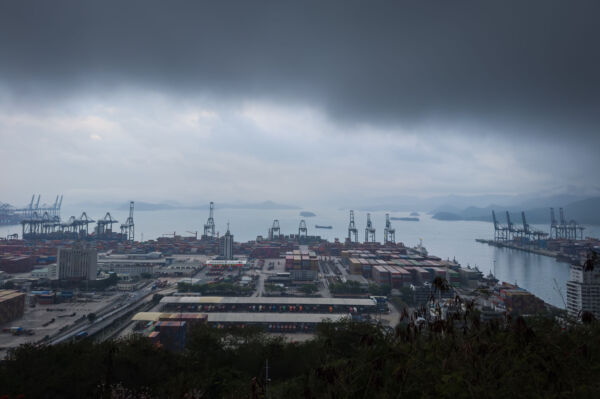Shenzhen, once known as the “Silicon Valley of Asia,” has been attracting attention for its economic situation following the COVID-19 pandemic. Observers have pointed out that with the withdrawal of foreign and Taiwanese enterprises, the local manufacturing and service industries have been severely impacted, leading to factory closures and a wave of unemployment, creating a bleak atmosphere with people resorting to sleeping in public places.
Recently, several social media influencers have shared observations on the current economic state of Shenzhen. A blogger named “996Rainmaker,” who has 545,000 followers, posted a video capturing scenes of people sleeping at places like Longhua Bus Station, squares, and parks. In the video, one interviewee mentioned being homeless for over twenty years in Shenzhen, spending nights under bridges or in parks, and now deciding to sleep in the square.
Another blogger, “Revealing Sister Shenzhen,” described the current situation in Shenzhen as facing the departure of foreign capital, relocation of Taiwanese companies, factory closures, mall shutdowns, rising unemployment among office workers, and people sleeping on the streets. She noted that the streets of the city are getting quieter with decreasing foot traffic, the subway ridership dropping significantly, and CBD office buildings becoming vacant or hollow headquarters. Even some Starbucks and McDonald’s stores in the Futian district have closed down and moved out of China.
“Revealing Sister Shenzhen” analyzed that Shenzhen’s transformation from a small fishing village to an international metropolis was largely due to the manufacturing, export, technological, and supply chains established by Taiwanese and foreign companies over decades. She observed that industrial areas in Longhua, Bao’an, Pingshan, and other places are currently languishing, with some Taiwanese factories collectively relocating to Vietnam, India, Indonesia, leading to equipment being taken away and local workers losing their jobs.
She further described how Luohu Square is filled with migrant workers who have nowhere else to go. At night, areas like under bridges in Futian CBD, subway entrances, and behind office buildings can be seen with people sleeping on cardboard, including unemployed programmers, construction workers, and delivery drivers, scavenging for job opportunities during the day and spending nights outdoors, with some even resorting to eating instant noodles and drinking tap water to save money.
According to public information, Futian CBD is a significant business district in mainland China boasting over 20 buildings taller than 200 meters.
Following the COVID-19 pandemic, reports from various sources, including foreign media and mainland Chinese self-media, have highlighted the trend of foreign capital leaving China and the diminishing attractiveness of China to foreign investment.
One notable example is a Hong Kong-owned household appliance company in Shenzhen, with a history of 38 years, announcing its closure on August 18, 2023, due to deteriorating business conditions post-pandemic.
Han Dongfang, an individual monitoring the labor situation in China, pointed out that business closures in Chinese enterprises have been widespread since 2023, and it’s uncertain if this trend has peaked and will pass. He likened the situation to a tsunami reaching the shore, with uncertainty on when it will recede.
In September last year, the Center for Strategic and International Studies (CSIS) in the United States released a research report on Taiwanese enterprises titled “Diversification Rather Than Decoupling – Taiwan Industries Respond to Geopolitical Risks.”
The report revealed that 57.4% of Taiwanese companies are considering or have already started withdrawing from mainland China. This survey was conducted at the end of 2023 among 610 Taiwanese enterprises. The study showed that the top three reasons for Taiwanese companies withdrawing from mainland China were high labor costs (33%), potential supply chain disruptions (25.9%), and changes in investment policies (25.2%). The report emphasized that the proportion of Taiwanese companies inclined to withdraw from mainland China far exceeds that of companies from other countries.
“Revealing Sister Shenzhen” questioned the strategies of the local authorities in addressing these challenges. She believed that the authorities have not actively tried to attract foreign capital and Taiwanese companies back, nor have they implemented large-scale tax cuts or fee reductions to ease the burden on businesses, or relaxed regulations to encourage order and fund inflows. On the contrary, she observed that the authorities have tightened restrictions on business withdrawals and capital movements. For example, if a Taiwanese company wants to withdraw, it must go through layers of filing and approval processes, while foreign exchange settlements also face stricter scrutiny and delays. Some business owners who tried to quietly shut down their factories encountered obstacles.
“A bunch of bosses initially planned to quietly shut down and lock the door in secret, but ended up having their doors blocked overnight. Some Taiwanese and foreign bosses simply dismantled their equipment overnight and moved them out. They were afraid of being caught day by day. It’s no longer an international metropolis, but a modern urban dilemma of high prices, high pressure, high unemployment, low hope, low wages, and low sense of security. This city is running out of vitality. The government is clinging onto the last bit of popularity, practically nailing people down to this land. No leaving, no running, no complaining, and definitely no speaking out the truth…”

